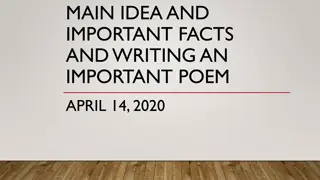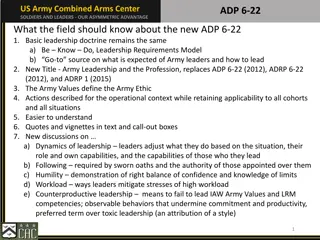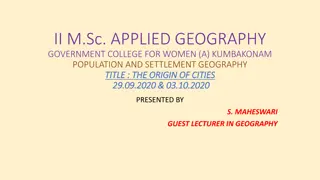Evolution of Communication, Clothing, and Leadership in Ancient & Modern Egypt
In Ancient Egypt, hieroglyphics were used for communication, Pharaohs ruled over dynasties, and people wore unique linen clothing. Modern Egypt has evolved with English and Arabic as spoken languages, while food habits have diversified. Explore the cultural transition from ancient traditions to modern practices in Egypt.
Download Presentation

Please find below an Image/Link to download the presentation.
The content on the website is provided AS IS for your information and personal use only. It may not be sold, licensed, or shared on other websites without obtaining consent from the author. Download presentation by click this link. If you encounter any issues during the download, it is possible that the publisher has removed the file from their server.
E N D
Presentation Transcript
KiaraMelo 5-305
-Ancient Egyptian Communication -Ancient Egyptian Food -Ancient Egyptian Leaders -Ancient Egyptian Clothing -Ancient to Modern -Modern Egyptian Communication -Modern Egyptian Leaders -Suez Canal
In Ancient Egypt, people communicated using hieroglyphics. Hieroglyphics was the writing of using drawings to represent words and meanings. For example, the letter K is represented using the bowl. Another example is using words. The word Pharaoh is used using the Stool; Rope; Vulture; Mouth; Vulture; Lasso; and House.
Ancient Egyptian Leaders were called Pharaohs. There were about 170 Pharaohs throughout the 30+ dynasties. Some Pharaohs include Cleopatra VII, Tutankhamun, Hatshepsut, Khufu, and RamessesII and III. These Pharaohs intermarried. This means the married daughter, granddaughters, sisters and brothers, to keep the throne in the family.
In Ancient Egypt, people wore unusual clothes. Men working outside usually wore short skirts. Ordinary Egyptians wore a tunic. A Tunic is a long t-shirt which draped towards the knees for men. For women, they were draped down to the ankles. They were normally made form linen. They often wore sandals or leather sandals. But the poor generally walked barefoot.
Modern Egypt does not resemble their ancient face, as pictured in tombs & hieroglyphs. There was no more mummifications. There was more freedom involved. Egyptians began to travel and leave.
Now in Egypt, people talk English. Most Egyptians have stayed in Egypt and still communicate using Hieroglyphics. But during the 7thDynasty, people now begin to speak Arabic.
Egyptians still eat the common food. Bread, Beer, Vegetables, Fruit, Figs, Coconuts and Fish. Since Egyptians are now traveling they are beginning to eat and learn new food and food combinations. For example, they now eat rice.
PharaohicEgypt ended two thousand years ago. Egyptians were finally ruled by Egyptians after the 1952 revolution. Currently, Egypt is under military rule.
PharoahicEgypt ended two thousand years ago. Egyptians were finally rule by Egyptians after the 1952 Revolution. Currently, Egypt is under military rule. They believe in religions. This includes Islam, Christianity, Greek Orthodox, Roman Catholicism, and Judaism.
The Suez Canal is what bridges Ancient Egypt and Modern Egypt together. The Suez Canal is the most manly made canal and the first canal connecting the Mediterranean Sea to the Red Sea. It took 10 years to construct and it was completed on 1869 in the Gulf of Suez in Egypt. This canal was supposed to make routes to places shorter. The first man to start digging was the pharaoh of Egypt; Senausert III. It was opened for ships to sail through in November 17th 1869. The canal has only one traffic line passing bays, which means there is only one way for boats to pass through. The canal is mostly used by modern day ships and is the fastest way to go from the Atlantic Ocean to the Indian Ocean.
1. www.abc.net.au/news/2014-08-06/egypt- begins-work-on-new-suez- canal/5651416 2. http://www.worldatlas.com/aatlas/infopage/su ezcanal.htm 3. http://www.touregypt.net/suezcanal.htm 4. http://www.bbc.com/news/world-middle- east 30895545


![[PDF⚡READ❤ONLINE] Tutankhamun's Trumpet: Ancient Egypt in 100 Objects from the](/thumb/20549/pdf-read-online-tutankhamun-s-trumpet-ancient-egypt-in-100-objects-from-the.jpg)




















